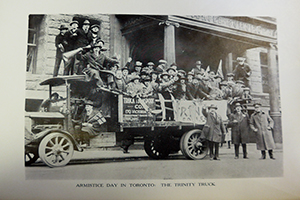Trinity Remembers
The Great War 1914-1918
Each year on November 11, Canadians fall silent on the anniversary of the armistice that ended the First World War. It is a time to reflect, remember and to commemorate those who sacrificed their lives.
 This year, many of the devastating battles of the Great War reached their centenaries, including Vimy Ridge, Passchendaele and the Third Battle of Ypres. To commemorate the sacrifices of the Trinity community, an exhibit capturing some of the narratives of the Great War is currently on display in the Trinity College Archives: “Trinity at War: 1914-1918.”
This year, many of the devastating battles of the Great War reached their centenaries, including Vimy Ridge, Passchendaele and the Third Battle of Ypres. To commemorate the sacrifices of the Trinity community, an exhibit capturing some of the narratives of the Great War is currently on display in the Trinity College Archives: “Trinity at War: 1914-1918.”
The First World War was fought on a scale never before imagined, and many men in the Trinity community answered the call to arms. Two of the Trinity men who fought were Reginald Prinsep Wilkins and Gordon McMichael Matheson. The two met as freshman in Trinity’s Class of 1914. Together they played football and sang in the Glee Club. After graduating from Trinity, Wilkins enrolled in law school at Osgoode Hall and Matheson entered the Faculty of Medicine. In December 1915, Wilkins and Matheson enlisted in the army. The Trinity University Review, May-June 1918, reports that “Lieuts’ G.M.Matheson and R.P. Wilkins have at last obtained the object of their desire and gone to France.” Sadly, the October issue contains their obituaries. Matheson fell at the Battle of Amiens on August 11. Wilkins, who learned of his friend’s death on August 19 shortly before he was sent to France, was killed in the battle of Bourlon Wood on September 27.
The women of St. Hilda’s College were also active. They worked as nurses, ambulance drivers, clerks, physicians and support personnel. Several St. Hildians were sent to France to work in military hospitals and to take part in the ambulance convoys close to the Western Front. One St. Hildians was alumna Ethel Ridley. From October 1914 to December 1918, she served at military hospitals in England and France, including field hospitals that underwent shelling and bombardment. For her service, Ethel received many decorations and medals.
The Great War also had a significant impact on life back home at the College, drastically altering the demographics of Trinity’s students. In the 1913-1914 academic year, there were 169 students enrolled: 105 men and 64 women. By the third year of the war, and for the first time in Trinity’s history, more women graduated from the College than men. In 1917, Trinity had only one male graduate. By the autumn of 1918, there were 37 male students attending Trinity College, a mix of men under military age, returned soldiers and those no longer fit for active service.
The physical structure of Trinity College was affected by the war as well. By the fall term of 1915, Trinity House, the residence for freshman, had been closed due to reduced numbers in enrollment. Later it was used as a military hospital for returned convalescing soldiers. By 1916 the whole west wing of the main academic building closed and did not reopen for normal use until 1918. Throughout the war, parts of the college grounds were re-purposed for military use: the west wing for officers of the 28th Battalion (Northern Fusiliers), Convocation Hall for officers’ classes, the gymnasium for musketry drill, and the playing fields for parade grounds.
There were 543 men from the Trinity College community who registered to serve in the First World War. Seventy-three of these were undergraduates at the time of their enlistment. Of the men who answered the call to arms, 56 perished. Their names, and those who fell during the Second World War are engraved on the memorial wall in the Trinity College Chapel.
Come explore the incredible narratives commemorated in “Trinity at War: 1914-1918” exhibit. This display will remain in the Trinity Archives until the end of 2018.
(Sources: Trinity College Archives and Trinity Magazine Spring 2014 [PDF] Remembering the Great War)
Categories: Alumni; Discover Trinity


